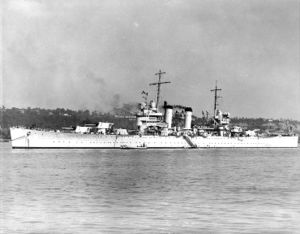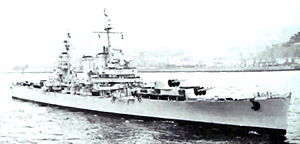- USS Brooklyn (CL-40)
-
For other ships of the same name, see USS Brooklyn.

USS Brooklyn in the Hudson River in 1939Career (United States) 
Laid down: 12 March 1935 Launched: 30 November 1936 Commissioned: 30 September 1937 Decommissioned: 3 January 1947 Fate: Sold to Chile in 1951 
O'Higgins (CL-02)Career (Chile) 
Name: O'Higgins Commissioned: 9 January 1951 Fate: Sank in 1992 under tow to breakers General characteristics Displacement: 9,700 tons Length: 608.3 ft (185.4 m) Beam: 61.7 ft (18.8 m) Draft: 24 ft (7.3 m) Speed: 33.6 kn (38.7 mph; 62.2 km/h) Complement: 868 officers and enlisted Armament: 15 × 6 in (150 mm)/47 cal guns, 8 × 5 in (130 mm)/25 cal AA guns[1] USS Brooklyn (CL-40) was a light cruiser, the lead ship of her class of seven, and the third United States Navy ship to bear its name. She was launched on 30 November 1936 by New York Navy Yard; sponsored by Miss Kathryn Jane Lackey, daughter of Rear Admiral F. R. Lackey; and commissioned on 30 September 1937, Captain W. D. Brereton, Jr. in command.
Contents
Inter-war period
Brooklyn joined the fleet in the Panama Canal Zone during the latter part of 1938. She was assigned to Cruiser Division 8 (CruDiv 8) and attended to routine duties with the fleet until April 1939. In mid-April, she returned to the United States where she participated in the opening of the New York World's Fair on 30 April 1939. On 23 May, Brooklyn was ordered to the scene of the Squalus disaster, 6 mi (9.7 km) south of the Isles of Shoals, New Hampshire. Until 3 June, she acted as a base ship during the salvage and rescue operations. Brooklyn then steamed to the west coast, where she joined the Pacific Fleet and participated in the opening of the Golden Gate International Exposition on 18 February 1940. She served on the west coast until March 1941, when she departed on a good-will and training tour of the South Pacific. In May, she left Pearl Harbor for the east coast where she joined the Atlantic Squadron. From 1–7 July 1941, she escorted the convoy carrying Marines to Reykjavík, Iceland. During the remainder of 1941, Brooklyn engaged in convoy escort and Neutrality Patrol.
World War II
With the entry of the United States into World War II, Brooklyn got underway from Bermuda to patrol the Caribbean Sea. In April 1942, she was assigned convoy escort duty between the United States and the United Kingdom. On 3 September, during one of the trans-Atlantic crossings, Wakefield, caught fire and was abandoned. Brooklyn rescued 1,173 troops which had been embarked onboard Wakefield. Although severely damaged by the fire, Wakefield was towed to safety and repaired.
On 24 October 1942, Brooklyn departed Norfolk, Virginia for North Africa. On 8 November, she bombarded shore installations to cover the Fedhala landing of Operation Torch. While engaged, she was hit by a dud projectile from a coastal gun, which damaged two of the cruiser's guns and wounded five of her crew. Following the Naval Battle of Casablanca Brooklyn departed Casablanca for the east coast on 17 November 1942. From January-July 1943, she made three convoy escort voyages between the east coast and Casablanca and then steamed to the Mediterranean where she carried out screening and fire support duties during the invasion of Sicily (10–14 July).
Remaining in the Mediterranean, Brooklyn next covered the Anzio-Nettuno landings (22 January – 9 February 1944), also known as Operation Shingle. From 13 to 23 May, she participated in the bombardment of the Formia-Anzio area and then carried out exercises in preparation for the invasion of southern France. On 15 August, Brooklyn furnished part of the heavy naval gunfire which preceded the landing of Allied troops on the coast of southern France. She remained on duty in the Mediterranean until 21 November, when she departed Sicily for New York, arriving on 30 November.
Post-war
From December 1944 to May 1945, Brooklyn underwent extensive overhaul and alteration at New York Navy Yard. From May-September 1945, she exercised along the eastern seaboard and then reported to Philadelphia Navy Yard for her pre-inactivation overhaul. She went in commission in reserve on 30 January 1946 and out of commission in reserve on 3 January 1947.
On 9 January 1951, Brooklyn was transferred under the Mutual Defense Assistance Program to Chile, where she was renamed O'Higgins after one of Chile's founding fathers, Bernardo O'Higgins , and she served for 40 years. She was sold for scrap in 1992, but foundered and sank off Pitcairn Island while under tow to shipbreakers in India.
Awards
Brooklyn received four battle stars for her World War II service.
Notes
- ^ Fahey 1941 p. 9
References
- Fahey, James C. (1941). The Ships and Aircraft of the U.S. Fleet, Two-Ocean Fleet Edition. Ships and Aircraft.
This article includes text from the public domain Dictionary of American Naval Fighting Ships. The entry can be found here.
External links
 United States Navy
United States Navy Argentine Navy
Argentine NavyGeneral Belgrano (ex-Phoenix) · Nueve de Julio (ex-Boise)
 Brazilian Navy
Brazilian NavyBarroso (ex-Philadelphia)
 Chilean Navy
Chilean NavyO'Higgins (ex-Brooklyn) · Capitán Prat (ex-Nashville)
Preceded by: Omaha class · Followed by: St. Louis class
List of cruisers of the United States NavyCategories:- Brooklyn class cruisers of the United States Navy
- Ships built in New York
- 1936 ships
- World War II cruisers of the United States
- United States Navy New York-related ships
- Brooklyn class cruisers of the Chilean Navy
Wikimedia Foundation. 2010.
